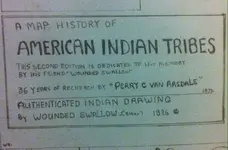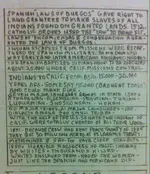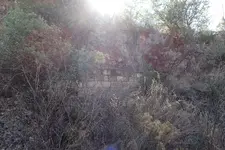SDCFIA wrote
We've pretty much all conceded that these sources, and probably more, provide a number of opinions that the Jesuits were involved in mining in AZ, at least to some degree. What we don't have is any evidence to support the pulp legends that specifically list several the exceedingly rich mines by name and provide inventory lists of huge caches of precious metals - all of which, with great effort, were cunningly hidden and then apparently abandoned and forgotten.
I confess that I won't take the time to read all this material, but let me ask you - do any of these sources discuss the specific flagship mines/caches that we've heard so many great things about? The provenance of these treasure tales, and many others not of Jesuit origin, is a great curiosity. I understand how typical people can get excited about these alleged treasures, based on the Jesuits' reputations (valid or not), but most of the furor seems to have come strictly from the media, or from alleged "documents" that surfaced to discuss the caches. My contention has always been that if these hoards were real, they were either recovered by their owners long ago, or they never existed to begin with. I tend to lean towards the latter, but with a stronger argument to the contrary, I would certainly change my tune.
Just what PULP LEGENDS do you refer to? How "exceedingly rich" do these legends claim?
Please cite some of these stories you keep referring to, so that we may compare those exaggerations to what we find stated by non-treasure-mag-sources, thanks in advance.
I would point out that there was a reported recovery of a sizable amount of treasure in the 1800s, of course it was reported by newspapers so you don't believe it.
Cactusjumper wrote
In the 249 years since the expulsion, no one has found the treasures of the Jesuit Southwest. This despite the soldiers who managed the expulsion, searching every nook and cranny in the missions. This would include searching the sewage pits. They found no treasures, no mines or signs of mining. In the following 249 years no subsequent treasure hunters have ever found a mine or treasure that could be authenticated as belonging to the Jesuit Order in Mexico or the Southwest.
On the other hand, there is good evidence that the Jesuits owned a few, very few, mines.
The first (15) Jesuits arrived in Veracruz in 1572. I believe the first precept against mining, or knowledge of mining, came along 127 years later. I could be wrong on that time period, as my mind don't work so well lately. If someone has a date for the mining precept that is earlier than 1699, please correct me.
I do not have the time right now, but the king of Spain had issued the first edict (law) against all clergy mining activity dates to the 1500s, and repeated several times over the centuries. You would think that a Spanish LAW would hold at least as much weight as a Jesuit Precept or rule. Considering that it was illegal for clergy to be owning and operating mines (not just Jesuits) it is remarkable that ANY mines would have been owned openly, yet such was the case.
Your detailed search of "every crevice" including sewage pits NEVER HAPPENED ON THE FRONTIER INCLUDING ARIZONA. NO troops were sent, there was NO roundup, they simply sent word (by Indian) and the padres came in voluntarily. In fact no search was done after the Jesuits left Arizona, not even an inventory done until the arrival of the Franciscans and NO search is mentioned by that inventory either. This was a revelation for me as well, but it has been posted here before, and likewise no detailed search was done in most of Baja either. In fact at one mission the padre came trooping out to meet the Spanish sent to arrest him, along with a horde of loyal Indians, indicating that word had preceded the arrest. If you have the time sometime, look into the "arrest" of the Jesuits in Arizona, and the subsequent search for treasures, do not take my word on this and don't be surprised.
As to that demand for authenticated treasures, if that is your <not just you Joe> main point then we have wasted a terrific amount of time. We are NOT the first treasure hunters to come along. Treasures often are extremely difficult to identify just who or whom originally owned them. Who owned a bar of silver, which has no owners marks on it? We do NOT have all the documents that once existed. When the Americans arrived in Arizona, anyone could literally walk into the old Jesuit missions and simply help themselves to any and all documents that looked interesting. Worse, and I can not blame them for this but in later years the Franciscan padres occupying a couple of the missions were literally selling the old Jesuit documents for a dollar a page as a tourist item. It is remarkable that we have any at all remaining. So I will let you alone, and not continue to try to persuade you (not just you alone of course) when I do not know of any "authenticated" treasures that can be proven beyond all doubt to have belonged to the Jesuits. I remain respectfully in disagreement, however
I do respect your position.
Good luck and good hunting amigos, I hope you find the treasures that you seek.
PS while I was typing this up I noticed this which I had missed:
It seems possible that the Guevavi slag stories were created to give legs to the Jesuit treasure tales, as nothing further came from them.
The piles of slag at Guevavi are mentioned by archaeologists whom were studying the ruins. I doubt very much that archaeologists would have created the story of slag piles being found at the mission to give legs to a tale of Jesuit treasures. The slag piles at Tumacacori were the ones which were hauled away.
The piles at Guevavi remain today, only some of it was hauled away, if you don't mind risking arrest for trespassing, you can go and see them for yourself, I know of at least two piles still there. Guevavi is also where clear evidence of metal casting (copper) was found, which the archaeologists were quite surprised to find.
Oroblanco








 We could go a few rounds on that
We could go a few rounds on that 




